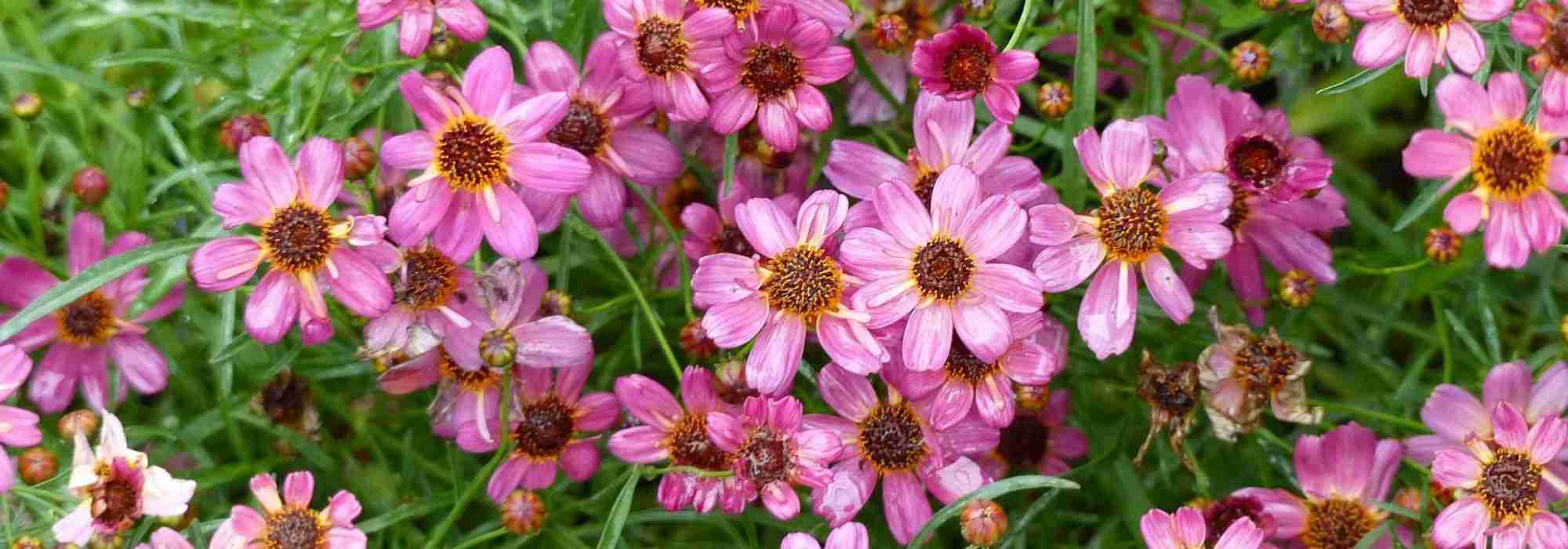
Choosing a Coreopsis
Discover our buying guide
Contents
Coreopsis, also known as tickseed, thrives in sunny locations and all types of soil, provided they are light and well-drained. The Coreopsis tinctoria is an annual, but the others are herbaceous perennials highly valued for their abundant flowering that lasts all summer into autumn. They are covered in single or double flowers, star-shaped or daisy-like, offering a palette of colours that is as stunning as it is vibrant. From yellow to red, pink to white, play with the different shades of blooms that contrast with finely dissected deciduous foliage. They require very little care and can easily withstand temperatures down to -15°C. Here are some tips for choosing the Coreopsis varieties you need for your balcony, in a corner of the terrace, or in a bed or border.
According to height
Perennial Coreopsis form compact, dense clumps, often bushy, reaching up to 1.80 m for the Coreopsis tripteris with most measuring between 30 and 60 cm in height. Once well established in light, well-drained soil, they will thrive and bloom in your green space for many years to come.
Small Coreopsis
With heights ranging from 15 cm to 30 cm, these varieties will brighten the foreground of borders or create edging. Plant them in quantity in open ground to form carpets of groundcover.
The Coreopsis lanceolata ‘Walter’, auriculata ‘Nana’, and auriculata ‘Elfin Gold’ will not exceed 15 cm in height.
The Coreopsis ‘Honeybunch Red & Gold’ can grow up to 25 cm tall.
Most coreopsis reach 30 cm in height, such as ‘Cosmic Eye’, ‘Sterntaler’, ‘Madras Magic’, ‘American Dream’, ‘Sunstar Rose’, ‘Desert Coral’, ‘Uptick Gold and Bronze’, or ‘Uptick Yellow and Red’.
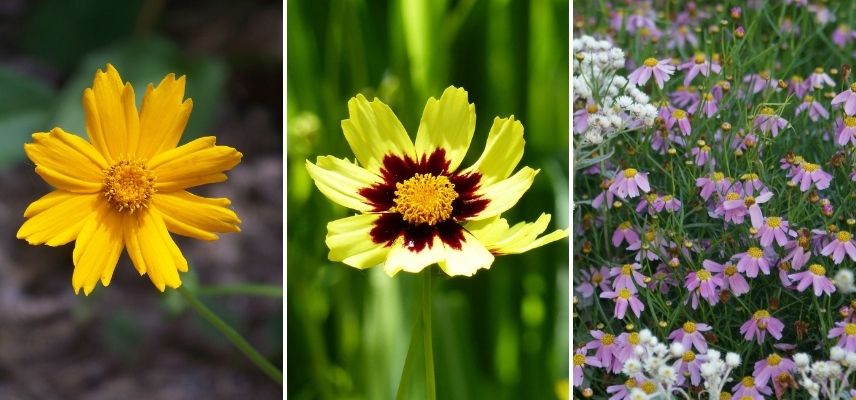
Coreopsis reticulata ‘Nana’, Coreopsis ‘Cosmic Eye’ and Coreopsis ‘American Dream’
Medium-sized Coreopsis
Their height can vary between 40 and 90 cm. They are perfect for densifying the heart of shrub borders, adding colour to a slope or rockery, or decorating your interior in a seasonal bouquet.
The Coreopsis grandiflora ‘Sonnenkind’, grandiflora ‘Sunray’, ‘Limerock Ruby’, ‘Mercury Rising’, ‘Red Satin’, rosea ‘Sweet Dreams’ or Coreopsis verticillata ‘Bengal Tiger’ reach 40 cm in height.
The Coreopsis ‘Redshift’, ‘Ruby Red’ or verticillata ‘Moonbeam’ develop stems of 50 cm in height.
The Coreopsis ‘Full Moon Madness’, lanceolata ‘Baby Gold’, or ‘Limerock Passion’ have stems of 60 cm in height.
The Coreopsis grandiflora ‘Louis d’Or’ can reach 70 cm, while the Coreopsis grandiflora ‘Badengold’ bears tall stems of up to 90 cm in height.
Large Coreopsis
This is the Coreopsis tripteris, highly ornamental, which stands out with its stems of 1.80 m tall, and its summer flowers release an anise scent when crushed.
Read also
Coreopsis : to sow, to plant, to growBy colour
Highly floriferous and ornamental, Coreopsis amaze with their extensive colour diversity. Whether solid or bicoloured, they provide contrast in borders or displays with warm, vibrant colours, alongside bushes and other flowering perennials. Here are some colours to grow:
Yellow Coreopsis
Pale yellow with verticillata ‘Moonbeam’;
Bright yellow with a red eye featuring Coreopsis lanceolata ‘Baby Gold’ or ‘Sterntaler’ ;
Golden yellow with a bronze centre featuring Coreopsis ‘Uptick Gold and Bronze’ or ‘Uptick Yellow and Red’;
Bright yellow with Coreopsis auriculata ‘Nana’ or ‘Citrine’.
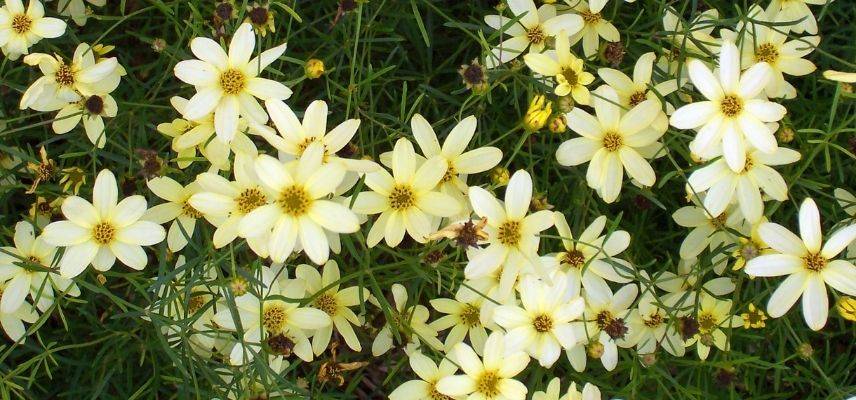
Coreopsis ‘Moonbeam’
Red Coreopsis
Red and yellow with Coreopsis ‘Honeybunch Red & Gold’;
Burgundy edged in yellow with Coreopsis ‘Cosmic Eye’;
Ruby red with Coreopsis ‘Limerock Ruby’ or ‘Ruby Red’;
Dark, velvety red with a golden heart featuring Coreopsis ‘Mercury Rising’;
Vibrant red with a yellow heart featuring Coreopsis ‘Red Satin’.
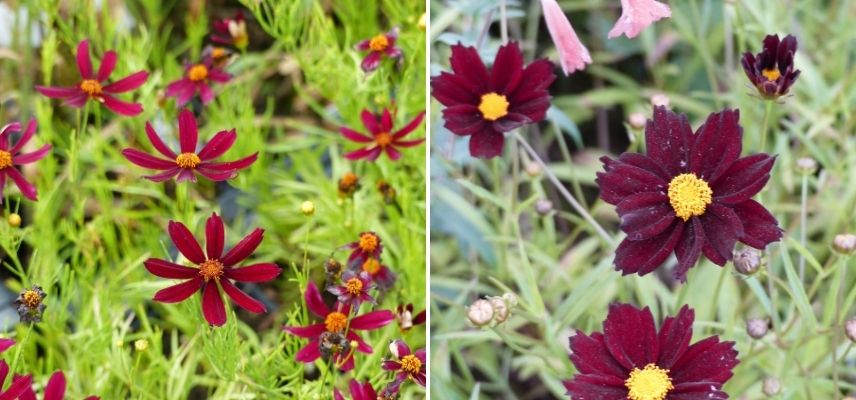
Coreopsis ‘Red Satin’ and ‘Mercury Rising’
Pink Coreopsis
Magenta pink with Coreopsis ‘Limerock Passion’;
Pink with a raspberry heart featuring Coreopsis ‘Madras Magic’.
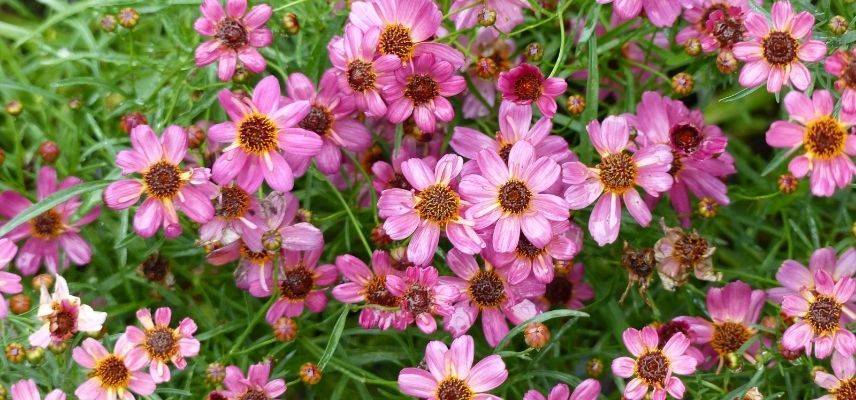
Coreopsis ‘Limerock Passion’
Coreopsis in other colours
Creamy white with a raspberry centre featuring Coreopsis rosea ‘Sweet Dreams’;
Peach-salmon and red with Coreopsis ‘Desert Coral’.
Discover other Coreopsis - Tickseed
View all →Available in 1 sizes
Available in 1 sizes
Available in 1 sizes
Available in 2 sizes
Available in 1 sizes
Available in 2 sizes
Available in 1 sizes
Available in 1 sizes
Available in 2 sizes
Available in 1 sizes
According to the flowering period
Once established in full sun and well-drained soil, coreopsis flowers from summer through to autumn. The flowerings are appreciated for being continuous and very abundant. The majority of varieties bloom from June until October. An exception is Coreopsis lanceolata ‘Walter’, which will only flower from July to August.
According to the shape of the flowers
Some Coreopsis bear large daisy-like flowers that can be single, semi-double, or double. The ligules may be more or less tapered, rectangular, and dentate depending on the variety.
- Single-flowered Coreopsis: ‘Cosmic Eye’, ‘Full Moon Madness’, ‘Ruby Red’, ‘Citrine’
- Double-flowered Coreopsis: grandiflora ‘Louis d’Or’, grandiflora ‘Sonnenkind’, grandiflora ‘Sunray’, ‘Uptick Cream’
- Star-flowered Coreopsis: lanceolata ‘Baby Gold’, ‘Sterntaler’ or ‘Madras Magic’
Feel free to mix varieties to multiply shapes, heights, and colours.

Coreopsis ‘Baden Gold’, ‘Bengal Tiger’ and ‘Baby Gold’
According to the foliage
The deciduous foliage of Coreopsis is either finely dissected linear or elongated, resembling ears (Coreopsis auriculata). Highly decorative, it remains green with some variations depending on the current light conditions.
According to their hardiness
This perennial plant is very hardy. Once established in well-drained soil, as it dislikes moisture and heavy soils, it can withstand temperatures down to -15°C. Be careful with the annual Coreopsis x tinctoria which is frost-sensitive.
According to the use
The multitude of shades and the floribundity of Coreopsis make it a superb plant to grow for adding colour to a border, a bed, or a rockery. The lightness of its stems and the wild aspect of this plant will enliven a wild garden or a bank, especially when paired with ornamental grasses or echinaceas. For medium-sized varieties, dare to grow them in containers or pots. Finally, Coreopsis are excellent cut flowers for creating seasonal arrangements. Cut stems from the beds or create a cut flower garden designed for this purpose. Enjoy their generous, bright, and almost maintenance-free flowering to add a splash of colour to your garden, balcony, or terrace.
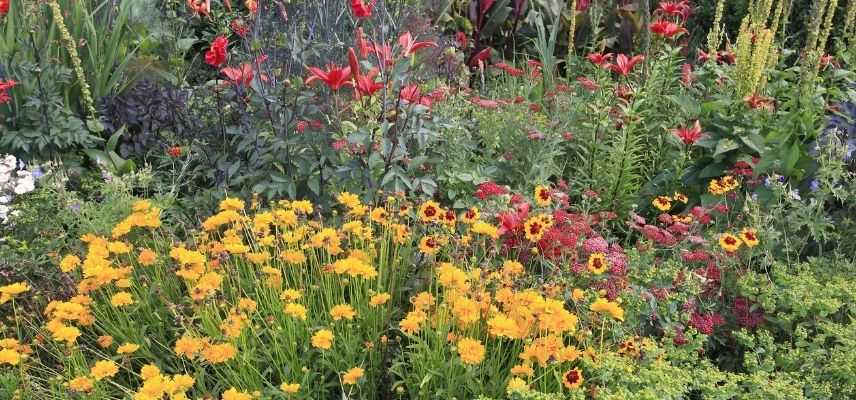
Bed with Coreopsis, Lilies, Mullein, Euphorbias, Bronze Fennel, Hardy Geraniums, Achilleas, etc.
For further reading
- Here are some valuable tips for successfully growing coreopsis with our guide Coreopsis: sowing, planting, growing.
- To avoid any failures, we recommend planting appropriately. Don’t hesitate to adopt our Plantfit web application!
- Subscribe!
- Contents
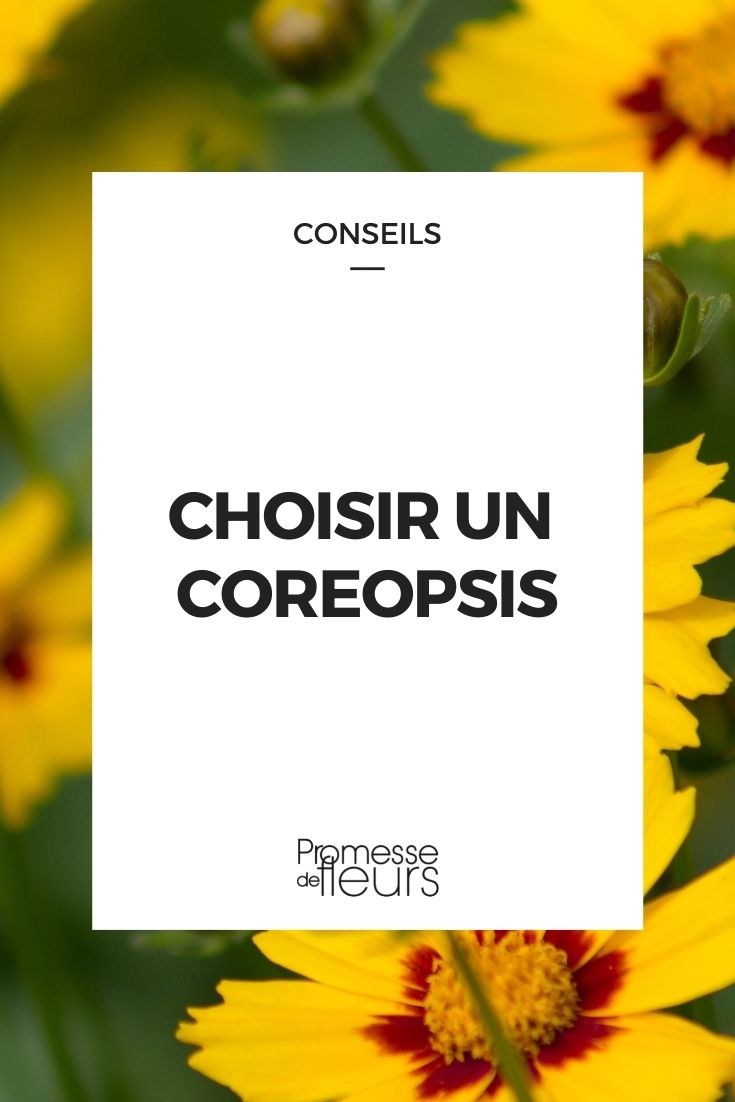
































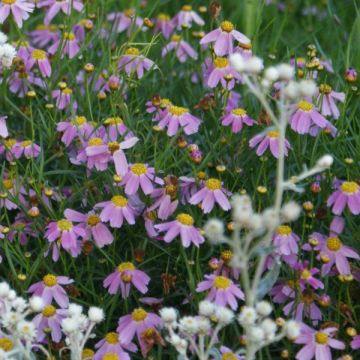
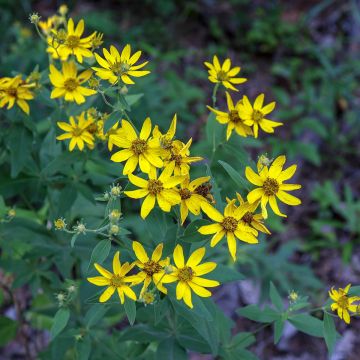

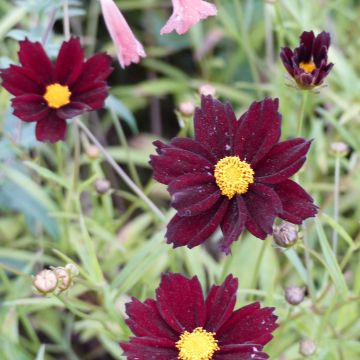
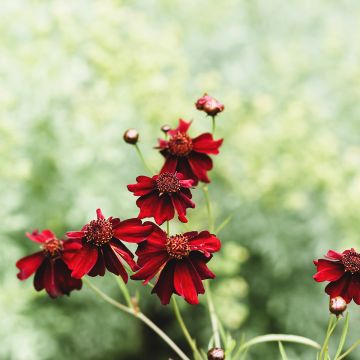

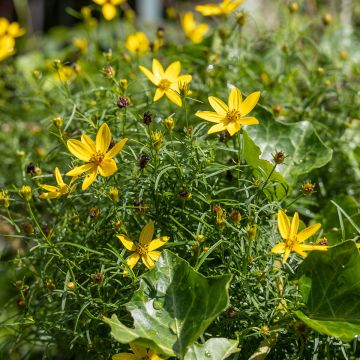
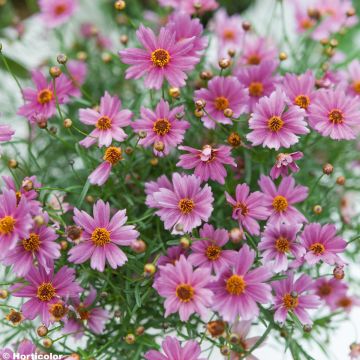
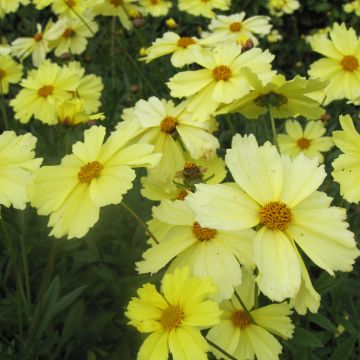
Comments